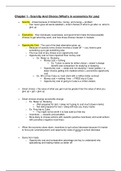Summary
Microeconomics complete summary
- Institution
- York University (Ebor )
A complete summary of all the chapters from the microeconomics for life book. Can use it for exams as well, helped me get an A in the course. The perfect set of notes to help you prepare for your econ 1000 exams. Has lots of images graphs and highlights to help you learn.
[Show more]




